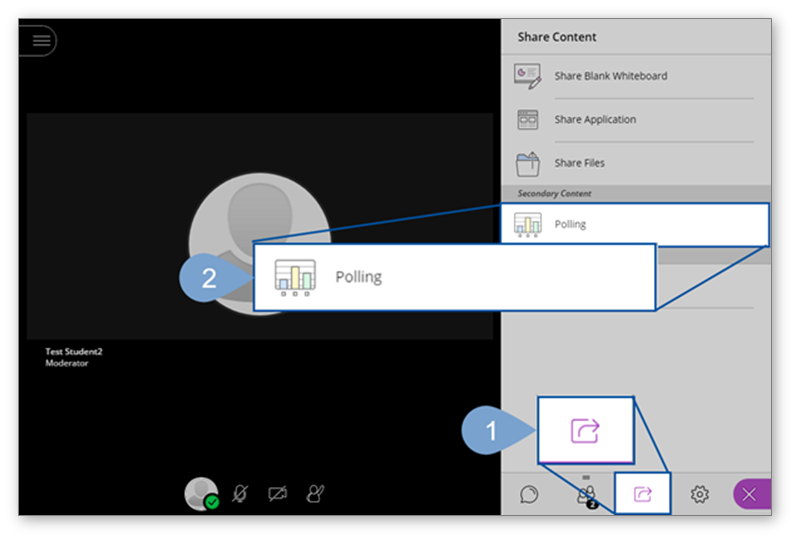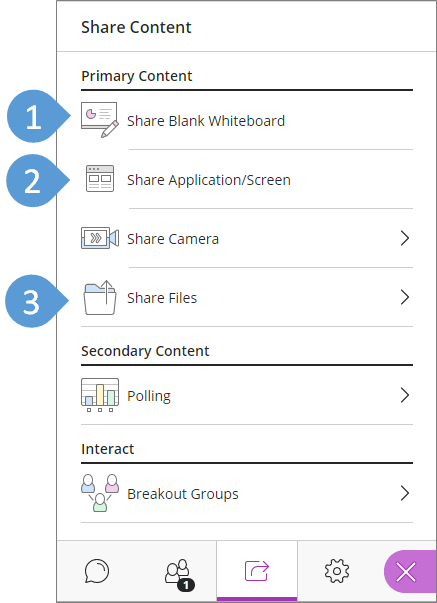Student participation using Collaborate Ultra
The following article discusses teaching strategies and ideas on how you can improve student participation in your online classroom.
Please note
The following article discusses the use of Blackboard Collaborate Ultra; however, these teaching strategies can be applied to other online video platforms such as Zoom, even if the process is different.
Students can participate in a variety of ways in a synchronous Blackboard Collaborate Ultra session. However, you will need to actively invite students to participate through the questions you ask, the resources you provide and the activities you design.
Listen to Steve Rowe discuss how and why he uses chat and polling to encourage student participation.
Getting students involved
There are several tools that you can use to engage students including polls, feedback, whiteboards and file sharing.
Using the Polling tool
The Polling tool allows you to ask students questions, record the responses and collates the results.
- To access the Blackboard Collaborate Ultra Polling tool, click on Share Files (1) and then use the Polling (2) during lectures and tutorials to keep students engaged.
- Polling needs to be set up on the fly so the best practice is to think about the questions and answers ahead of time.
- Have your questions ready in a Word document that you can cut and paste into the Polling tool.
- Use polls to check for understanding by using multiple choice or yes/no questions. This is a good way to judge how much the students understood and what you need to review.
Using My Status and Feedback
The My Status tool allows moderators to ask questions and get feedback from students as they present information. Explain what you want students to do so they know how to use the feedback in this tool. Students can access the My Status and Feedback tool by clicking their profile circle located at the bottom centre of the screen in Blackboard Collaborate Ultra (shown below).
Ask students a question or present an argument, then ask students to click agree or disagree using the Feedback tool. Then, start a discussion on that topic.
For example:
Recessions/Depressions are healthy for an economy.
- Those who agree need to find some points to support their position.
- Those who disagree need to find some points to support their position.
Students can post their text responses and links into the chat, and you can discuss one side at a time.
Make sure to set rules for chat during this discussion. You can then add other resources and links into a discussion forum where students then have resources to help with their persuasive essay assignment (this is one example of how you support an assignment in your activities).
Student contributions: Sharing links and videos in chat
Students can contribute to conversations and discussions by posting links to journal articles, websites and videos into the chat window.
- Be creative and ask students to work on research for assessment as a class activity, with each student posting links to useful journal articles and websites into the chat window.
- Ask a student/s to keep track of these posts and then collate them into a MySCU discussion forum thread for the assignment. This encourages student involvement, develops research skills, and builds assignment resources. Students are more likely to carefully evaluate resources when they know they are sharing them with others.
Student presentations
You can promote students to presenters which gives them access to the presentation options to Share Blank Whiteboard (1), Share Application/Screen (2) and Share Files (3).
Students can then upload PowerPoint slides and present the information to others in the main room. In the main room, these presentations will also be recorded. Using this method, groups of students can present an oral presentation as part of their assessment.
Using the whiteboard
You can have students work together on a whiteboard to solve problems and brainstorm ideas. The interactive nature of using the whiteboard to solve problems invites group collaboration, keeps participants engaged and makes lasting impressions. Having multiple participants take turns using the whiteboard creates engagement. Encourage students to draw fun visuals that relate to the topic with different colour markers to make the whiteboarding session more interesting.
To use the whiteboard effectively:
- focus your purpose – make sure you have a clear purpose and an end product in mind when using the whiteboard
- organise ideas using the drag feature as ideas emerge on the whiteboard so ideas are grouped
- create an area to hold ideas that fall outside of the purpose but could be addressed at a later date or through a Q&A document.
Sharing content with students
You can use the Share Content feature of Collaborate Ultra to engage students.
Sharing a video
Share audio and video streams to enhance a lecture or tutorial. You can use a video to emphasise meaning or as a discussion point. Pause the video where needed to discuss different parts and relate these back to theory or the current unit learnings - this helps students to visualise and engage with the content. Remember to always tie the video back to the unit learning outcomes or assessment.
Sharing software
Share an application to walk a student through how to use a specific piece of software. They can follow along as you demonstrate how to complete a specific task. This is a great example of I DO (Instructor demonstrates), WE DO, you have the class complete a task as you demonstrate so they can ask questions along the way, and YOU DO, you have the students complete a task on their own.
Sharing a website
Share a website in the same way that you share a video. Use a shared website to walk students through a website that they may need to use often (such as a library site) or show them how to look for journal articles.
Working through problems with students
Work through math exercises or problems that require steps with students. You can simply use your mouse to write on the whiteboard, blank slides in the PowerPoint presentation or slides with problems already on them. As an alternative, consider using an iPad or Microsoft Surface device with a digital pencil to write more accurately.
Working through problems in real-time with students is like having a personal tutor writing on a whiteboard in front of the class. You can provide the students with practice problems, and ask them to provide you with the steps they used to solve the problem, as you write it out in the online classroom.
Group work in breakout groups
Breakout groups can be used for discussions, solving problems, brainstorming or working on questions that will then be reported back to the full group. See Using breakout groups effectively for more details.


